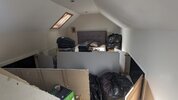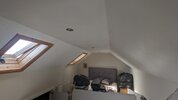- Joined
- 23 Jun 2024
- Messages
- 9
- Reaction score
- 0
- Country

Hi all. Recently, I found out that my loft has interstitial condensation. Our first step was to remove the insulation on either side; one side is nearly done.It is insulated halfway up on both sides. The problem is that there is a noggin between each pair of rafters, situated just before the pitched plasterboard meets the central boards, which run down the centre, which is visible from inside the eaves, looking up the inside of the pitch of the roof.
The house is from approximately the 1930's and the felt needs to be repaired in places. I'm happy for the room to be used as a loft rather than a bedroom in order to facilitate a quicker repair (it is going to be rented in August).
Does anyone have any ideas how to open up the structure for airflow, without ripping all of the boards out?
And... Can I leave the noggins in- or are they likely to be blocking airflow just like the insulation which is rammed in? Please see the photos attached, I welcome any advice. Thank you.
The house is from approximately the 1930's and the felt needs to be repaired in places. I'm happy for the room to be used as a loft rather than a bedroom in order to facilitate a quicker repair (it is going to be rented in August).
Does anyone have any ideas how to open up the structure for airflow, without ripping all of the boards out?
And... Can I leave the noggins in- or are they likely to be blocking airflow just like the insulation which is rammed in? Please see the photos attached, I welcome any advice. Thank you.



